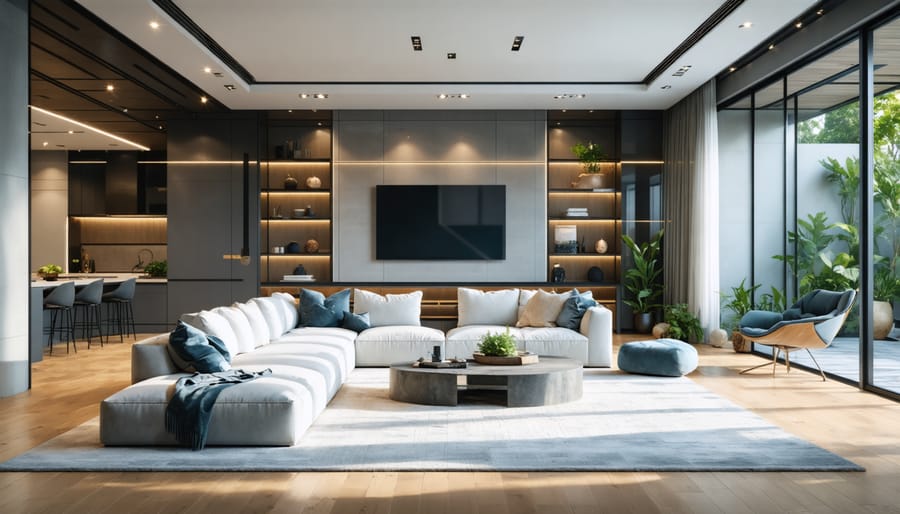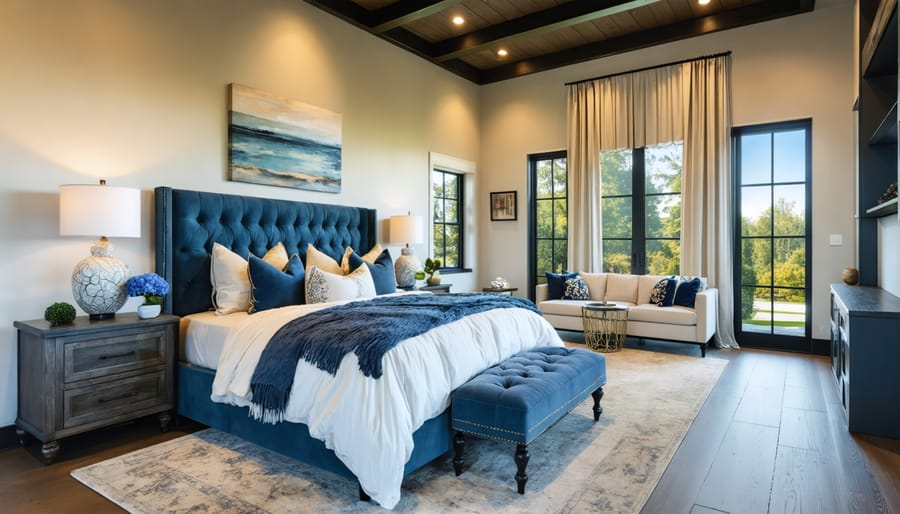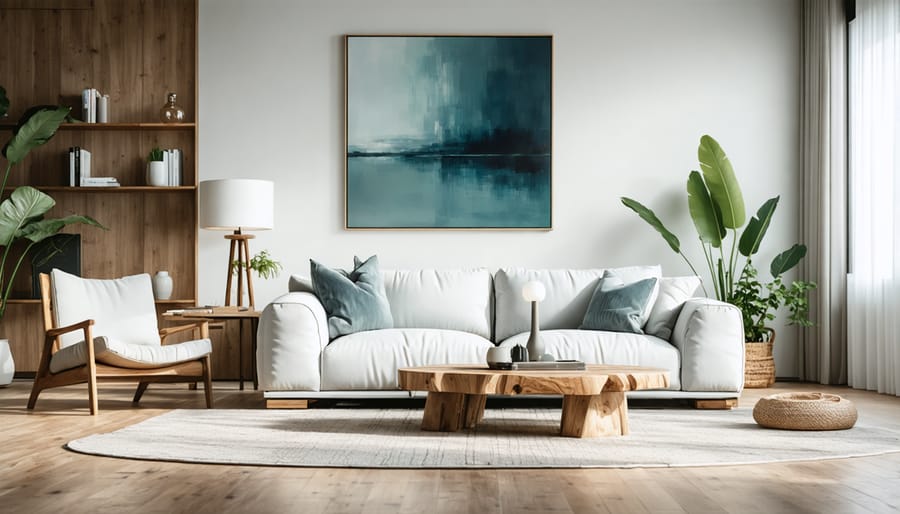Transform empty rooms into stunning, fully-furnished spaces in seconds with AI virtual staging—no moving trucks, no furniture costs, and no design degree required. This revolutionary technology is changing how we envision our homes, and many try to visualize their future furniture using staging tools that make professional interior design accessible to everyone.
Whether you’re a homeowner wanting to reimagine your living room, a real estate agent preparing listings that sell faster, or simply someone who dreams of refreshing their space without breaking the bank, AI virtual staging puts endless design possibilities at your fingertips. Upload a photo of any empty or outdated room, select your preferred style—from minimalist Scandinavian to cozy farmhouse—and watch as intelligent algorithms instantly populate your space with perfectly scaled furniture, curated decor, and harmonious color schemes.
The beauty lies in experimentation without commitment. Try a mid-century modern bedroom today, switch to coastal chic tomorrow, and compare both versions side-by-side before making any purchasing decisions. This technology eliminates the costly guesswork of traditional interior design, allowing you to explore multiple aesthetics, layouts, and furniture arrangements risk-free. Ready to discover how AI can transform every room in your home with specific, style-focused ideas that match your vision and budget? Let’s dive into the possibilities waiting in each space.
What AI Virtual Staging Actually Does (And Why It Matters)
Imagine walking through an empty room and instantly seeing it transformed into a cozy living space, complete with furniture, artwork, and perfect lighting—all without moving a single piece of actual furniture. That’s exactly what AI virtual staging does, and it’s revolutionizing how we envision and design our homes.
At its heart, AI virtual staging uses smart technology to digitally furnish empty or outdated spaces in photographs. Think of it as having a talented interior designer and photographer combined into one powerful tool. You start with a photo of your bare room—maybe that spare bedroom you’re not sure what to do with, or your living room that needs a fresh perspective. The AI analyzes the space, understanding dimensions, lighting, and architectural features, then adds realistic furniture, décor, and styling that fits perfectly.
What makes this technology truly special is its ability to learn from thousands of beautifully designed rooms around the world. It understands what works in different spaces, from cozy Scandinavian apartments to spacious modern lofts, giving you access to global design inspiration without hiring an expensive consultant.
The real game-changer? Speed and affordability. Traditional staging can cost thousands of dollars and take weeks to arrange. AI virtual staging delivers professional results in minutes for a fraction of the cost, making quality design guidance accessible to everyone—whether you’re planning a renovation, trying to sell your home, or simply dreaming up your next DIY project.
This isn’t about replacing the joy of hands-on decorating; it’s about giving you a clear roadmap before you invest time and money, helping you avoid costly mistakes and discover possibilities you might never have imagined.

Living Room Ideas That Make Buyers Stop Scrolling
Modern and Minimalist Living Spaces
AI virtual staging brings the essence of modern minimalism to life with crisp lines, open layouts, and a calming neutral color scheme. Picture a living room where a low-profile sectional in dove gray anchors the space, paired with a sleek glass coffee table and a single sculptural floor lamp. The beauty lies in what you *don’t* see—no clutter, no unnecessary decorative pieces, just intentional design choices that create breathing room.
When experimenting with AI staging for contemporary spaces, focus on furniture with clean geometric shapes and natural materials like light wood, metal, and stone. Think streamlined sofas with slim arms, floating media consoles, and abstract artwork in blacks, whites, and soft grays. These furniture placement strategies work especially well in smaller apartments where every inch matters.
AI tools excel at visualizing how negative space becomes a design element itself. Try staging with just three or four key pieces rather than filling every corner. Add warmth through texture—a chunky knit throw, a natural fiber rug, or linen curtains—while keeping the palette monochromatic. This approach proves that less truly can be more, creating serene sanctuaries that feel both sophisticated and surprisingly budget-friendly.
Cozy Traditional Arrangements
There’s something universally welcoming about a traditional living room—the kind that makes everyone want to sink into the sofa with a good book and a warm cup of tea. When using AI virtual staging to create these timeless spaces, think about the elements that have made homes feel cozy for generations.
Start with a rich, warm color palette. Deep burgundies, forest greens, warm taupes, and cream create an envelope of comfort that never goes out of style. AI tools excel at layering these colors throughout a space, from wall treatments to upholstery choices. Picture a plush sofa in a warm caramel fabric paired with patterned armchairs that invite conversation.
The magic of traditional design lies in its attention to detail. AI staging allows you to experiment with classic furniture pieces—think tufted sofas, wingback chairs, and sturdy wooden coffee tables with turned legs. These aren’t just furniture pieces; they’re investments that tell a story of quality and permanence.
Layering is essential in traditional spaces. Virtual staging makes it easy to add Persian or Oriental-inspired rugs, throw pillows in complementary patterns, and window treatments that frame views beautifully. Don’t forget those finishing touches that make a house feel like a home: table lamps with fabric shades, framed family photos (even if they’re staged), and perhaps a antique-style clock on the mantel.
For families viewing your staged property, these warm, inviting arrangements speak directly to their desire for a gathering place where memories will be made for years to come.
Bedroom Staging Ideas That Create Instant Appeal
Master Bedroom Retreats
Your master bedroom should feel like a personal sanctuary, and AI virtual staging makes it easy to explore luxurious designs before making any commitments. Start by experimenting with upholstered headboards in rich velvet or linen textures—AI staging lets you visualize how a statement headboard transforms the entire room’s ambiance. Layer in plush bedding with varied textures, from chunky knit throws to silky pillowcases, creating that hotel-inspired look we all crave.
Consider positioning a cozy reading nook by the window with an accent chair and floor lamp. AI tools can show you exactly how this setup balances the room without overwhelming your space. For smaller bedrooms, virtually stage floating nightstands and wall-mounted lighting to free up precious floor space while maintaining functionality.
Don’t overlook the power of accent walls—whether it’s a warm sage green, moody navy, or textured wood paneling. AI staging reveals how these bold choices pair with your existing furniture and lighting. The beauty of this technology is testing dramatic ideas like canopy beds or statement light fixtures without any risk, helping you create a retreat that’s both achievable and deeply personal.

Small Bedroom Solutions
Small bedrooms don’t have to feel cramped when you use AI virtual staging to explore space-maximizing layouts before moving a single piece of furniture. Start by visualizing a murphy bed or wall-mounted desk that folds away when not in use—AI tools can show you exactly how much floor space you’ll reclaim during waking hours.
Try staging your compact room with furniture that pulls double duty: an ottoman with hidden storage, a bed frame with built-in drawers underneath, or floating nightstands that keep the floor clear. AI staging lets you test whether a full-size bed truly fits or if a clever daybed arrangement would serve you better.
Vertical space becomes your best friend in small bedrooms. Use AI to experiment with floor-to-ceiling wardrobes, wall-mounted shelving above the headboard, or even lofted sleeping areas if your ceiling height allows. Light colors and strategically placed mirrors can make rooms feel surprisingly spacious—stage different paint colors virtually to see which shades open up your space.
The beauty of AI staging is testing bold ideas risk-free. That corner you thought was wasted? AI might reveal it’s perfect for a cozy reading nook with a hanging chair and slim bookshelf.
Kitchen and Dining Spaces That Feel Like Home
The kitchen is more than just a place to cook—it’s where morning coffee rituals happen, homework gets done at the counter, and friends naturally gather during parties. AI virtual staging helps you showcase this heart-of-the-home feeling, whether you’re working with a sprawling open-concept layout or a cozy galley kitchen.
For open-concept spaces, AI tools excel at defining zones without losing that coveted flow. Picture a sleek island with bar stools that creates a natural boundary between cooking and living areas, paired with pendant lighting that draws the eye and adds warmth. The AI can test different configurations—maybe moving the dining table closer to windows to capture natural light, or angling it to improve conversation flow with the living room.
Galley kitchens present unique challenges, but AI staging transforms them into efficient, stylish workspaces. By virtually placing light-colored cabinetry and adding a small bistro set at one end, these narrow spaces suddenly feel functional rather than cramped. The technology can also show how glass-front cabinets or open shelving creates visual depth.
For dining areas, AI staging brings personality through details that matter. A farmhouse table with mismatched chairs tells a collected-over-time story, while a modern glass table with sculptural lighting suggests sophisticated entertaining. The beauty is testing multiple styles instantly—rustic Italian villa one moment, minimalist Scandinavian the next.
Don’t forget the practical touches that make kitchens feel lived-in: a fruit bowl on the counter, cookbooks on display, or a coffee station in the corner. These AI-added elements help potential buyers or renters envision their own daily routines unfolding in the space, turning a generic kitchen into *their* future kitchen.
Home Office and Multi-Purpose Room Ideas
The shift to remote work has transformed how we view our homes, and AI virtual staging is revolutionizing the way we design spaces that work overtime. Whether you’re carving out a corner for video calls or creating a room that transitions from homework station to guest bedroom, AI can show you exactly how to make it happen.
Picture this: a spare room that feels empty and purposeless suddenly comes to life through AI staging. Add a sleek desk positioned by the window for natural light, floating shelves that maximize vertical space, and a comfortable reading chair in the corner for when work is done. The beauty of AI is how quickly you can test different layouts—desk against the wall versus facing the room, L-shaped configuration for more surface area, or a standing desk setup for better ergonomics.
For families juggling multiple needs, AI staging excels at showing functional workspace design that adapts throughout the day. Imagine a Murphy bed that folds up to reveal a full office, or a console table that doubles as both a desk and entryway piece. AI can stage these transformations, helping you visualize how one room can genuinely serve many purposes.
The secret is choosing furniture that pulls double duty—storage ottomans, fold-away desks, and modular shelving units. AI staging lets you experiment with these solutions risk-free, ensuring your multi-purpose room works for your real life, not just in theory.
Style-Specific AI Staging Inspiration
Scandinavian Simplicity
Imagine waking up in a space where soft morning light filters through sheer curtains, highlighting clean lines and natural wood tones—that’s Scandinavian simplicity at its finest. AI virtual staging brings this beloved Nordic aesthetic to life by focusing on functionality without sacrificing beauty. Picture a living room with a streamlined gray sofa, a simple wooden coffee table, and perhaps a cozy sheepskin throw draped casually over a chair. The color palette stays neutral—whites, grays, and beiges—allowing natural materials like light oak, linen, and wool to shine. Add a few carefully placed houseplants and minimal artwork, and you’ve created that effortlessly chic Scandinavian vibe. The beauty of using AI for this style is how it emphasizes what matters: open space, natural light, and pieces that serve a purpose while looking absolutely beautiful.

Bohemian and Eclectic Vibes
AI virtual staging brings bohemian interiors to life with rich tapestries, vintage rugs layered over natural fiber flooring, and an artful mix of throw pillows in clashing-yet-cohesive patterns. Picture a reading nook where a macramé wall hanging meets Moroccan poufs, or a living room showcasing globally-inspired textiles from your travels—real or aspirational. The beauty of AI staging is experimenting fearlessly with maximalist combinations: rattan furniture paired with jewel-toned velvet, plants cascading from every corner, and curated collections of ceramics and artwork. This style celebrates personal expression without the commitment of buying every piece first. You can test whether that Persian-inspired runner really works with your existing furniture, or if mixing ikat curtains with geometric cushions creates the cozy, collected-over-time vibe you’re after. It’s perfect for budget-conscious decorators who want to preview thrifted finds virtually before investing.
Coastal and Farmhouse Charm
Coastal and farmhouse styles create homes that feel instantly welcoming—the kind of spaces where guests kick off their shoes and stay for hours. These designs work beautifully for AI virtual staging because they balance comfort with visual appeal, making properties feel lived-in yet aspirational.
Coastal staging embraces soft whites, sandy neutrals, and ocean blues, with natural textures like jute rugs and driftwood accents. Think airy living rooms with linen sofas and woven baskets that capture that breezy vacation-home feeling. Farmhouse charm leans on rustic wood tones, shiplap walls, and vintage-inspired pieces—perfect for showcasing character in older homes or adding warmth to new builds. AI tools excel at adding these signature touches, from decorating wall features with reclaimed wood shelving to placing that perfect farmhouse dining table. Both styles photograph exceptionally well and resonate with buyers seeking that cozy, timeless aesthetic that never goes out of style.
Budget-Friendly Tips for Getting the Best Results
Getting stunning results from AI virtual staging doesn’t require a hefty budget—you just need to know the right approach. Several platforms offer free trials or basic plans that work beautifully for homeowners experimenting with design ideas. BoxBrownie.com and RoomsGPT provide limited free credits to start, while VisualStager offers affordable pay-per-image options perfect for staging one or two key spaces. These budget-friendly design solutions give you professional-quality results without the commitment of monthly subscriptions.
The secret to impressive AI staging begins with your photography. Clear, well-lit photos produce dramatically better results than dim or blurry images. Stand in the doorway or corner of your room to capture the widest view possible, making sure your camera lens is level with the floor to avoid distorted perspectives. Natural daylight works wonders—photograph during mid-morning or late afternoon when sunlight fills the space evenly. Remove personal items, clutter, and existing furniture if you’re starting fresh, as clean spaces give AI tools more flexibility to work their magic.
Common mistakes can waste both time and money. Avoid uploading photos taken at odd angles or with harsh shadows, as these confuse the AI and create unrealistic results. Don’t over-furnish your virtual spaces—the AI might suggest filling every corner, but real rooms need breathing room. Also, stay consistent with your style choices across connected spaces. If your living room showcases modern minimalism, don’t jump to ornate traditional in the adjacent dining area.
Remember, AI staging works best as an inspiration tool. Use it to visualize possibilities, experiment with color schemes, and identify furniture arrangements that maximize your space before making real purchases.
AI virtual staging has opened up a world of possibilities for transforming your living spaces without the heavy price tag or commitment of traditional design. Whether you’re preparing to sell your home, refreshing a tired room, or simply exploring new design directions, this technology puts professional-level creativity right at your fingertips.
The beauty of AI virtual staging lies in its flexibility. You can experiment with coastal vibes in your bedroom today and try out minimalist Scandinavian design tomorrow—all without moving a single piece of furniture. It’s like having a global house tour that you can customize to match your unique vision and lifestyle needs.
Remember, these AI-generated designs aren’t just pretty pictures to admire. They’re actionable blueprints for your real-world spaces. Start small by virtually staging one room, then use those insights to guide your actual furniture purchases and DIY projects. Many homeowners find that seeing their space transformed digitally gives them the confidence to take that first step toward change.
Your home should tell your story and reflect who you are. AI virtual staging is simply a powerful tool to help you discover what’s possible. So dive in, play around with different styles, and don’t be afraid to mix ideas from various designs. The perfect space for you is waiting to be discovered—and now you have the technology to visualize it before making any commitments. Your design adventure starts today.
